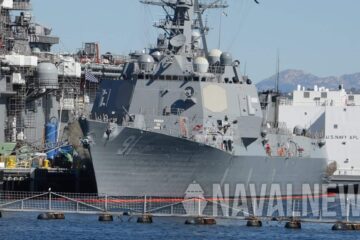“Zumwalt is designed for stealth,” said Capt. Andrew Carlson, the ship’s commanding officer. “This aids her role as a multi-mission surface combatant and improves the fleet commander’s options for delivery of naval combat power to meet the Navy’s emergent mission requirements.”
Zumwalt’s crew recently completed a post-delivery maintenance availability designed to thoroughly evaluate the ship’s systems and equipment to include radars and engineering plant.
“My crew has been looking forward to continued testing and operations at sea, leveraging the newly installed capabilities of this platform,” said Carlson. “Our primary focus is executing a safe underway, while building both competence and confidence in operating Zumwalt across the spectrum of naval warfare.”
Zumwalt is under operational control of U.S. 3rd Fleet. Third Fleet leads naval forces in the Pacific and provides the realistic, relevant training necessary for an effective global Navy. Third Fleet coordinates with U.S. 7th Fleet to plan and execute missions based on their complementary strengths to promote ongoing peace, security, and stability throughout the entire Pacific theater of operations.
The nearly 16,000-ton Zumwalt was built by General Dynamics Bath Iron Works in Bath, Maine. The ship is 190 meters in length, has a beam of 24.6 meters, and a navigational draft of 8.4 meters. The ship is powered by two Rolls-Royce main turbine generators, two Rolls-Royce auxiliary turbine generators, two 34.6 MW advanced induction motors to speeds up to 30-plus knots.
The USS Zumwalt includes new technologies and will serve as a multi-mission platform capable of operating as an integral part of naval, joint or combined maritime forces. The Zumwalt-class fields a considerably larger flight deck and has capacity for two MH-60R and three VTOL UAVs to execute a wider array of surface, aviation, and undersea missions that deliver more manpower, firepower, and computing power to the fight. The Zumwalt’s Vertical Launch System (VLS) features cells physically larger than similar cells on today’s ships, allowing this class to fire larger and more advanced land and anti-ship missiles in the future.






